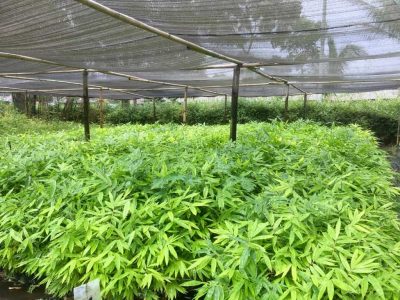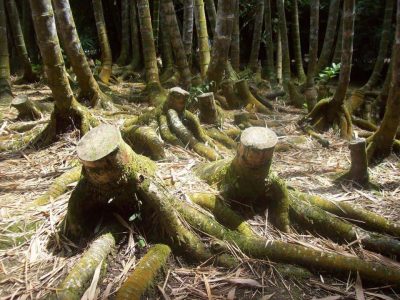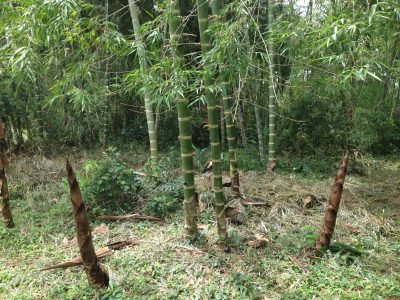Bamboo is known as an incredibly sustainable and environmentally friendly product. But why is bamboo environmentally friendly?
- Bamboo grows extremely fast. As a result, it can be harvested quickly and frequently in a relatively small area.
- Bamboo does not need pesticides, insecticides or fertilisers to grow well.
- Bamboo stems are masters at absorbing water and therefore need little extra water to grow.
- If bamboo is cut correctly (just above the first or second node), it will grow back completely within a year. Bamboo does not need to be replanted after each harvest and recycles itself, as it were.
- Bamboo absorbs more CO2 than other plants/trees.
- Unprocessed bamboo is biodegradable and can be composted.
BAMBOO VERSUS WOOD
Bamboo grows quickly and delivers high productivity. There are 1500 different species of bamboo, 50 of which are suitable as structural building material. Because bamboo is a grass (the Gramineae), it can shoot up to 30 metres from the ground within six months. The largest known bamboo species is Dendrocalamus, which grows up to 40 metres high and 30 centimetres per day. One bamboo root produces 15 kilometres of usable trunk, which means a large amount of usable raw material and a beautiful cycle.
In bamboo plantations, only the mature bamboos are harvested and the rest are left to develop. When harvesting, care is taken to leave enough of the stem so that a new bamboo stem can grow. This new bamboo stem will then have the nutrients and root system of the harvested bamboo, which of course will only benefit the new bamboo. When a bamboo seed is planted, it forms a clump under the ground. This clump can absorb up to 2 tons of CO2 in its 7 year turnaround time. This compares to a hardwood tree that absorbs only 1 ton of CO2 in 40 years.



Bamboo has a turnover time of seven years. In the case of wood, it is 30 years. So this is already a big difference. The actual record time is 1.22 metres per day. Bamboo has hardwood properties but grows faster than softwood. Every year more than 13 million hectares of forest are cut down. That is 1140 football fields every hour. Of course forests are planted, but the annual net loss of forest is over 7 million hectares, which is more than twice the size of Belgium. If these forests were not cut down, up to a quarter less CO2 would be emitted into the atmosphere.
The use of bamboo greatly reduces the greenhouse effect and climate change. Bamboo absorbs greenhouse gases. The carbon dioxide (CO2) emissions of bamboo release 35% more oxygen into the atmosphere than an equivalent species of hardwood. This is due to its high growth rate and photosynthesis. Climate change has been a problem for some years now, and therefore bamboo could be included as a certified hardwood. Bamboo is also suitable for biomass production because it gives the second highest biomass on earth.
BAMBOO IN NATURE
Bamboo is also essential in regulating the quantity and quality of water. Because of the water absorption system in the bamboo stem, it works almost like a water pump. When it rains, it absorbs water and this water is then released into the earth when there is a drought. One hectare of bamboo can store as much as 30,000 litres of water. This allows bamboo to grow in difficult conditions where other plants would not last. It also improves the quality of the soil because its roots hold it together. This also reduces the risk of landslides and erosion by rivers.
Bamboo is also an important part of many biodiverse ecosystems. There are several animals worldwide that use bamboo for food and shelter. A well-known example is the giant panda (from China), but also the red panda (China), mountain gorilla (Uganda), half-maki (Madagascar), balemeen cat (Ethiopia) and the Gracilinanus agilis (South America). Apart from these animals, there are also many birds that benefit from bamboo. Planting bamboo can therefore quickly provide the right conditions for these species.
BAMBOO IN BUILDING CONSTRUCTIONS
In the European context, we use bamboo in the garden and as a finishing material. But why is it not used more often as a building material in Europe? After all, bamboo is one of the strongest building materials in the world. It has a tensile strength of 28,000 inches per square millimetre compared to 23,000 inches for steel. One learns from nature by researching the structure of bamboo, because nature builds much more efficiently than we do. We build rigidly, but with the help of less rigid dampers and elastic springs that look like the construction system of a bamboo stem, we can build less rigidly.
![]()
